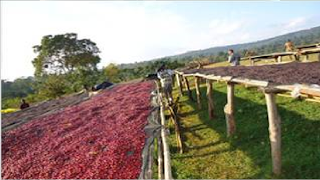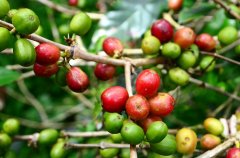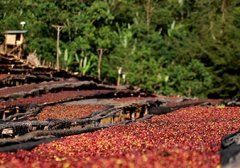Ethiopian Coffee Manor-the country with the largest variety of coffee in the world-Ethiopia

For professional baristas, please follow the coffee workshop (Wechat official account cafe_style)
Ethiopia is the Garden of Coffee Eden and the hometown of coffee.
Genesis in the Bible says that the beautiful space where Adam and Eve first lived was the Garden of Eden, where God placed the man he had created so that all kinds of trees could grow out of the ground, pleasing to the eyes, and having fruit on it for food. A river flows out of the garden of Eden and moistens it, and there is a tree of life and a tree that distinguishes good from evil. ● "the tree of good and evil": the original text is "tree, knowledge, good and evil", that is, "the tree of knowledge of good and evil". The fruit of this tree should be that when people eat this fruit, they can distinguish between right and wrong, good and evil by their own standards. Is it coffee called the mysterious fruit? Ethiopia claims to be the Garden of Coffee Eden, so the paradise of Adam and Eve must be in Ethiopia. It is not a masterstroke, it is the hometown of native coffee, this is the hometown of coffee. A treasure trove of coffee breeders' genes.
There are thousands or even tens of thousands of coffee beans in Ethiopia. Researchers and the coffee industry still know little about these varieties, many of which are wild and have not yet been found in the mountains and forests. About 15 million of the population in Ethiopia is related to coffee production. More than 1.1 million coffee growers, mostly in the form of cooperatives of small farmers, account for about 95% of Ethiopia's coffee production, and coffee production accounts for more than half of Ethiopia's GDP.
Ethiopia is the first place in the world to find coffee trees.
Ethiopia is the first place in the world where coffee trees are found, and coffee is grown almost everywhere in the country. It is divided into east and west walls by the East African Rift Valley, forming their own evolution. Due to the obstruction of the Great Rift Valley in East Africa, the types of coffee beans on the two half walls are different, the beans of the Hara varieties in the eastern half are thinner, with the difference between long body and short body, and the varieties of the virgin forest in the west are numerous and complex, and the beans of Irubabo, Tana Lake and Jinbi in the northwest are obviously stronger. East: capital Hara (Harar), West Dharma (Sidamo), Yega Xuefei (Yirgacheffe) mainly. In particular, the Eastern Highland Hara (Harra) produces the famous Haramoka, which has a special wine aroma and acidity, which is equivalent to the Yemeni mocha and is a high-quality coffee.
West: Lake Tana (Lake Tana), the capital Gimbi, Nekemti, Iruba, Limu, and Jimma, Bonga, Teppi, Bebeka of the Canadian Forest. Sidamo and Djimmah in the south are also well-known coffee producers, and the coffee produced is slightly different from that produced by Hara, with a refreshing sour taste and drupe aromas. In Sidamo, there is a community function variable called Yirgacheffe, which produces coffee with very charming features, with aromas of jasmine and lemon, as well as a special taste as sweet as honey. Ethiopian authorities have registered trademarks for domestically produced coffee beans to improve the quality and protect the interests of farmers, including Yirgacheffe, Sidamo and Harar. At the same time, the way coffee beans are traded has been changed. The harvest of small farmers is collected by the joint cooperative, which is uniformly classified by the official ECX Exchange (Ethiopian Commodity Exchange) and sold in the name of the joint cooperative. It has changed the model of raw bean merchants purchasing directly from individual small farmers in the past. Become the country with the most diverse government tutoring cultivation system. Forest coffee (Forest coffee) refers to wild coffee trees in primeval forests. Protected by the government, there are special personnel to harvest. The total output is only 10% of 5m / m. Semi-forest coffee (Semi-forest coffee) refers to semi-wild coffee. Farmers regularly go to the forest to trim shade trees or coffee branches and leaves to increase light transmittance and fruit yield. The total output accounts for 35%. Rural coffee (Garden coffee) refers to small farmers grow their own, mixed with other cash crops, mostly under the elephant legs. The total output accounts for 50%. Plantation Coffee (Plantation coffee) open up state-owned or private land, similar to the entrepreneurial and scientific management in Central and South America. The total output accounts for only 10% of 5muri. Ethiopia, the birthplace of coffee, has been drinking coffee longer than anyone else. Coffee is their national drink, even when eating staple food injera. Ethiopian restaurants are always full of fireworks, and most of them bake their own coffee for guests.
[coffee drinking ceremony]
It is an ancient and elegant art in Ethiopia. At the beginning of the ceremony, order aromatherapy, spread a new tablecloth, put on the best coffee cups, and then start roasting coffee beans. Charcoal fire slowly roast coffee beans, roast black and bright, and then let the guests smell the coffee beans. After picking out the sundries, put them into a wooden bowl and mash them into powder with a wooden pestle. This is a very important study for every Ethiopian, and holding a coffee drinking ceremony is a very grand thing in Ethiopia.
Important Notice :
前街咖啡 FrontStreet Coffee has moved to new addredd:
FrontStreet Coffee Address: 315,Donghua East Road,GuangZhou
Tel:020 38364473
- Prev

Guatemala Coffee San Felisa Manor what is the batch of orange honey treatment independent bidding manor introduction
For the exchange of professional baristas, please follow the coffee workshop (Wechat official account cafe_style) Guatemalan Coffee San Ferissa Manor bourbon honey treatment Guatemala Santa Felisa Bourbon Orange Honey on Stonework, the most popular raw bean bidding platform in the world. Every year, four bids are held independently, except for Jade Geisha and Best.
- Next

Characteristics of G1 taste of Ethiopian sun-exposed Gujiambela coffee beans description of hand-made flavor of Huakui coffee
For the exchange of professional baristas, please follow the coffee workshop (Wechat official account cafe_style) to bask in the G1EthiopiaHambelaBentiNenquaG1NaturalSFPSLDLot121 flavor of Gujimbela Manor: rich tropical fruit style.
Related
- Does Rose Summer choose Blue, Green or Red? Detailed explanation of Rose Summer Coffee plots and Classification in Panamanian Jade Manor
- What is the difference between the origin, producing area, processing plant, cooperative and manor of coffee beans?
- How fine does the espresso powder fit? how to grind the espresso?
- Sca coffee roasting degree color card coffee roasting degree 8 roasting color values what do you mean?
- The practice of lattes: how to make lattes at home
- Introduction to Indonesian Fine Coffee beans-- Java Coffee producing area of Indonesian Arabica Coffee
- How much will the flavor of light and medium roasted rose summer be expressed? What baking level is rose summer suitable for?
- Introduction to the characteristics of washing, sun-drying or wet-planing coffee commonly used in Mantenin, Indonesia
- Price characteristics of Arabica Coffee Bean Starbucks introduction to Manning Coffee Bean Taste producing area Variety Manor
- What is the authentic Yega flavor? What are the flavor characteristics of the really excellent Yejasuffi coffee beans?

